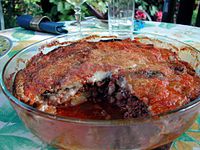- Moussaka
-
Moussaka is an eggplant based dish of the Balkans, Eastern Mediterranean, and the Middle East. The best known variation outside the region is the Greek one.[1]
Contents
Names and etymology
The name comes from the Arabic: مسقعة musaqqaʿa 'chilled'.[2][3] This name is used in Greek cuisine (μουσακάς), Turkish (musakka), and the South Slavic languages (musaka/мусака). Other languages call it simply "eggplant casserole" (e.g. Hungarian rakott padlizsán).
Preparation
Most versions are based primarily on sautéed eggplant (aubergine) and tomato, usually with minced meat. The Greek version includes layers of meat and aubergine topped with a white sauce/Béchamel sauce and baked. Turkish musakka, on the other hand, is not layered. Instead, it is prepared with sautéed aubergines, green peppers, tomatoes, onions, and minced meat. It is eaten with cacık and pilaf. There are also variants with zucchini, carrots and potatoes. The Serbian version and Bulgarian version use potatoes instead of aubergines, pork mince and the top layer is yogurt mixed with raw eggs and a couple of spoons of flour. In the Arab world, moussaka is a cooked salad made up primarily of tomatoes and aubergine, similar to Italian parmigiana, and is usually served cold as a mezze dish.
The modern Greek version was probably invented by Tselementes in the 1920s.[4] It has three layers: a bottom layer of sautéed aubergine slices; a middle layer of cooked ground lamb cooked with onion, garlic, chopped tomatoes, herbs, and spices (cinnamon, allspice and black pepper); and a top layer of béchamel sauce or egg custard. The composed dish is baked until the top layer is browned. Moussaka is usually served lukewarm.
In Serbia and Bulgaria there is also a three-layer version: the bottom layer consists of ground pork and beef, the middle layer slices of potatoes, the top layer a custard. Each layer is cooked on its own and layered in a pan and baked until the top layer is browned.
In the rest of the Balkans, the top layer is often a custard. This is the version which was introduced into the UK by Elizabeth David's Mediterranean Cookery and where it remains as the "classic" presentation. Grated cheese or bread crumbs are often sprinkled on top.
There are variations on this basic recipe, sometimes with no sauce, sometimes with other vegetables. The most common variant in Greece may include courgette (zucchini), part-fried potatoes or sautéed mushrooms in addition to the aubergine. There is even a fast-day version in the Greek cookbook by Tselementes which includes neither meat nor béchamel sauce, just vegetables (ground aubergine is used instead of ground meat), tomato sauce, and bread crumbs. In some cases, moussaka is also decoratively layered on top of grape leaves (a common ingredient in Greek cuisine, also used for example in dolmades).
See also
References
- ^ http://www.cooks.com/rec/view/0,1626,149174-229204,00.html
- ^ "moussaka". The American Heritage Dictionary of the English Language. Bartleby.com. http://www.bartleby.com/61/roots/S347.html. Retrieved 2008-04-17.
- ^ "moussaka". Dictionary.com Unabridged (v 1.1). Lexico Publishing Group, LLC. http://dictionary.reference.com/browse/moussaka. Retrieved 2008-04-17.
- ^ Aglaia Kremezi, "'Classic' Greek Cuisine: Not So Classic", The Atlantic, Sunday, July 13, 2010 full text
Appetizers Greek salad · Mezes · Bakaliaros · Dakos · Dolmadakia · Fava · Garides Saganaki · Gavros · Kroketes · Horta · Kalamarakia · Kolokythakia · Kolokythopita · Kolokythoanthoi · Melitzanes · Melitzanosalata · Octopus · Patatosalata · Pita · Manitaria · Saganaki · Skordalia · Spanakopita · Taramosalata · Tyropita · TzatzikiCheeses Anthotyros · Feta · Graviera · Kasseri · Kefalotyri · Kefalograviera · Formaela · Myzithra · Manouri · Metsovone · Metsovela · Xynotyro · Xynomizithra · HalloumiDishes Aginares a la Polita · Astakos · Arakas me aginares · Avgolemono · Astakomacaronada · Baked lamb with potatoes · Bamies · Briám · Fakes · Fasolada · Fasolakia · Gemista · Giouvetsi · Gigandes plaki · Gyros · Hilopites · Kotosoupa · Keftedakia · Kokoretsi · Lachanorizo · Loukaniko · Macaronada · Magiritsa · Manestra · Moussaka · Mydia · Paidakia · Pastitsio · Pork with celery · Psarosoupa · Revithia · Soutzoukakia Smyrneika · Souvlaki · Souvla · Spanakorizo · Spetsofai · Stifado · Strapatsada · XiphiasDesserts Amygdalotá · Bougatsa · Cake · Copenhagen (dessert) · Diples · Finikia · Galaktoboureko · Galatopita · Glika tou koutaliou · Granita · Halvas · Karydopita · Koulourakia · Kourabiedes · Loukoumades · Soutzouki · Loukoumi · Melomakarona · Milopita · Moustalevria · Moustokouloura · Profiterole · Rizogalo · Tsoureki · Tulumba · Vasilopita · Yoghurt with honey and walnutsDrinks Wine · Beer · Frappé coffee · Greek coffee (Turkish/Arabic) · Diktamo · Kitron · Metaxa · Mavrodafni · Ouzo · Retsina · Mastichato · Soumada · Tsipouro · Tsikoudia · Tentura · Kumquat · ZivaniaCategories:- Eggplant dishes
- Arabic words and phrases
- Balkan cuisine
- Middle Eastern cuisine
- Casserole dishes
Wikimedia Foundation. 2010.

